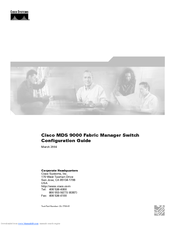Cisco DS-C9216I-K9 Fabric Switch Manuals
Manuals and User Guides for Cisco DS-C9216I-K9 Fabric Switch. We have 1 Cisco DS-C9216I-K9 Fabric Switch manual available for free PDF download: Configuration Manual
Cisco DS-C9216I-K9 Configuration Manual (436 pages)
Switch Guide
Table of Contents
-
-
Call Home49
-
IP Storage49
-
-
-
Switch Roles84
-
-
-
Software Images
109 -
Managing Modules
115 -
-
-
How Vsans Work130
-
-
TL Port139
-
TE Port139
-
SD Port139
-
ST Port140
-
Fx Port140
-
B Port140
-
Auto Mode140
-
-
Reason Codes141
-
Default Settings146
-
About Trunking149
-
-
-
Zoning Features164
-
Zoning Example165
-
Zone Sets169
-
The Default Zone176
-
Zone Enforcement176
-
LUN Zoning178
-
Read-Only Zoning179
-
-
-
-
About IVR181
-
IVR Features182
-
IVR Terminology182
-
IVR Guidelines183
-
Configuring IVR184
-
Enabling IVR184
-
-
-
-
-
-
Displaying FDMI192
-
-
Sending Rscns193
-
-
-
-
CLI Security198
-
SNMP Security198
-
-
-
Authentication199
-
-
Authorization199
-
-
VSA Format202
-
-
Local AAA205
-
-
SNMP Version 3210
-
-
-
-
-
About DHCHAP220
-
Enabling DHCHAP221
-
-
-
-
About Auto-Learn227
-
-
-
-
FSPF Examples236
-
FSPF Features236
-
Redundant Links237
-
Default Settings244
-
Default Settings245
-
-
Configuring IPFC254
-
-
Configuring VRRP256
-
VRRP Features257
-
Default Settings260
-
-
-
About FICON264
-
Enabling FICON274
-
Port Swapping281
-
-
-
-
Configuring VRRP292
-
Configuring CDP294
-
IPS Core Dumps294
-
About FCIP295
-
Configuring FCIP295
-
FCIP Link296
-
FCIP Profiles296
-
Enabling FCIP297
-
FCIP Interface297
-
Creating Tunnels299
-
Fspf310
-
Vrrp311
-
-
About Iscsi313
-
Enabling Iscsi314
-
-
-
Static Importing316
-
Dynamic Mapping321
-
Static Mapping321
-
-
-
Cisco Autonotify338
-
Default Settings340
-
Event Triggers340
-
Message Contents344
-
-
-
Enabling FCC364
-
FCC Process364
-
Control Traffic365
-
Data Traffic365
-
Default Settings368
-
-
-
Default Settings376
-
-
About SPAN389
-
SPAN Sources390
-
SPAN Sessions393
-
Remote SPAN398
-
Sample Scenarios405
-
-
-
GUI-Based Client412
-
-
-
-
Advertisement
